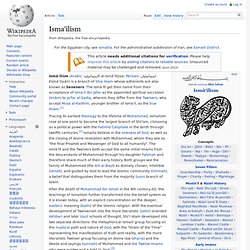

Sevener. Seveners (Arabic: سبعية) are a branch of Ismā'īlī Shīʻa.

They became known as "Seveners" because they believe that Ismā'īl ibn Jaʻfar was the seventh and the last Imām (hereditary leader of the Muslim community in the direct line of ʻAlī ibn Abī Tālib). They believed his son, Muħammad ibn Ismā'īl al-Maktum, would return and bring about an age of justice as al-Mahdi. Their most famous and active branch were the Qarmatians. Twelver. Twelvers, Twelver Shī'ite or Imamiyyah (Imami Shi'a Islam) (Arabic: اثنا عشرية, Athnā‘ashariyyah or Ithnā‘ashariyyah; Persian: شیعه دوازدهامامی, pronounced [ʃiːʔe-je dævɑzdæh emɑmiː]) is the largest branch of Shī'ī (Shi'a) Islam.

Adherents of Twelver Shī'ism are commonly referred to as Twelvers, which is derived from their belief in twelve divinely ordained leaders, known as the Twelve Imāms, and their belief that the Mahdi will be the returned Twelfth Imam who disappeared and is believed by Twelvers to be in occultation. A majority of Shī'a Muslims are Twelvers. The term Shi'a Muslim may also be used to refer to Zaydis and Ismailis. People of the Twelver faith form a majority in Iran, Iraq, Azerbaijan and Bahrain, and form a plurality in Lebanon and form a significant minority in Kuwait.
Alevis in Turkey and Albania, and Alawis in Syria, also believe in the twelve Imams of the Twelver faith. Alternative names[edit] Ismailism. Ismāʿīlism (Arabic: الإسماعيلية al-Ismāʿīliyya; Persian: اسماعیلیان Esmāʿiliyān) is a branch of Shia Islam whose adherents are also known as Seveners.

The Ismāʿīlī get their name from their acceptance of Isma'il ibn Jafar as the appointed spiritual successor (Imām) to Ja'far al-Sadiq, wherein they differ from the Twelvers, who accept Musa al-Kadhim, younger brother of Isma'il, as the true Imām.[1] Tracing its earliest theology to the lifetime of Muhammad, Ismailism rose at one point to become the largest branch of Shī‘ism, climaxing as a political power with the Fatimid Caliphate in the tenth through twelfth centuries.[2] Ismailis believe in the oneness of God, as well as the closing of divine revelation with Muhammad, whom they see as "the final Prophet and Messenger of God to all humanity".
The Ismāʿīlī and the Twelvers both accept the same initial Imams from the descendants of Muhammad through his daughter Fatimah and therefore share much of their early history. History[edit] Zaza people. Mawlawi Order. Whirling Dervishes perform in the Galata Mevlevihane (Mevlevi Lodge), Istanbul.

In 2005, UNESCO proclaimed the "The Mevlevi Sema Ceremony" of Turkey as amongst the Masterpieces of the Oral and Intangible Heritage of Humanity.[9] Principles[edit] Model of a dervish studying The Mawlawi order was founded in 1273 by Rumi's followers after his death, particularly by his successor Hüsamettin Çelebi who decided to build a mausoleum for Mawlâna, and then Mawlâna's son, Baha al-Din Muhammad-i Walad (or Çelebi, Chelebi, meaning "fully initiated").
He was an accomplished Sufi mystic with great organizing talents. Rumi has said in reference to Sema: For them it is the Sema of this world and the other. Chiisme. Un article de Wikipédia, l'encyclopédie libre. Pour l’article homophone, voir schisme. Le chiisme (ou chî`isme[1]) constitue l'une des trois principales branches de l’islam avec le sunnisme et le kharidjisme. Il regroupe environ 10 à 15 % des musulmans, dont 90 % de la population iranienne. Les chiites sont souvent appelés péjorativement sous le nom de Râfidhites (en arabe : rāfiḍ, رافض, (pl.) rawāfiḍ روافض, « celui qui refuse », ou rāfiḍī, رافضي, « refuseur»), dont la communauté est appelée rāfiḍiy, ceux qui refusent les trois premiers califes (Abu Bakr, Omar et Othman).
Shia Islam. The Shia (Arabic: شيعة Shīʿah) represent the second largest denomination of Islam and adherents of Shia Islam are called Shias or the Shi'a as a collective or Shi'i individually.[1] Shi'a is the short form of the historic phrase Shīʻatu ʻAlī (شيعة علي) meaning "followers", "faction" or "party" of Muhammad's son-in-law and cousin Ali, whom the Shia believe to be Muhammad's successor in the Caliphate.

Twelver Shia (Ithnā'ashariyyah) is the largest branch of Shia Islam and the term Shia Muslim is often taken to refer to Twelvers by default. Shia Muslims constitute 10-20% of the world's Muslim population and 38% of the Middle East's entire population.[2] Bektachi. Un article de Wikipédia, l'encyclopédie libre.

Le bektashisme (en turc : Bektaşilik ; en albanais : Bektashizmi ou Bektashizëm) est un ordre religieux ésotérique (batinite), issu de la mouvance soufi de l'islam à l'origine même de nombreux autres ordres batinites (ghulat) et considéré comme une branche du chiisme par les Turcs car ses adeptes montrent un intérêt particulier pour l'Imam ʿAlī ibn Abī T̩ālib[1]. Beaucoup de ses rites sont spécifiques au bektachisme. Alaouites. Un article de Wikipédia, l'encyclopédie libre.

Les alaouites ou alawites (arabe : ʿalawīy, علويّ, alaouite; alawite), également appelés noseïris ou nusayris (nuṣayrī, نصيريّ, nusayrite), ou ansariyas sont un groupe ethnique et religieux issu du djébel Ansariya au nord de la Syrie. Répartition des communautés alaouites[modifier | modifier le code] Au début du XXIe siècle, ils forment entre 10 et 12 %[1],[2],[3] de la population de la Syrie, et des communautés alaouites existent au Liban et en Turquie, en particulier à proximité de la frontière syrienne (dans l’ancien sandjak d'Alexandrette). Origines et histoire[modifier | modifier le code] Le fondateur du noséirisme est Muhammad Ibn Nusayr al-Namîri al-`Abdi, mort en 884.